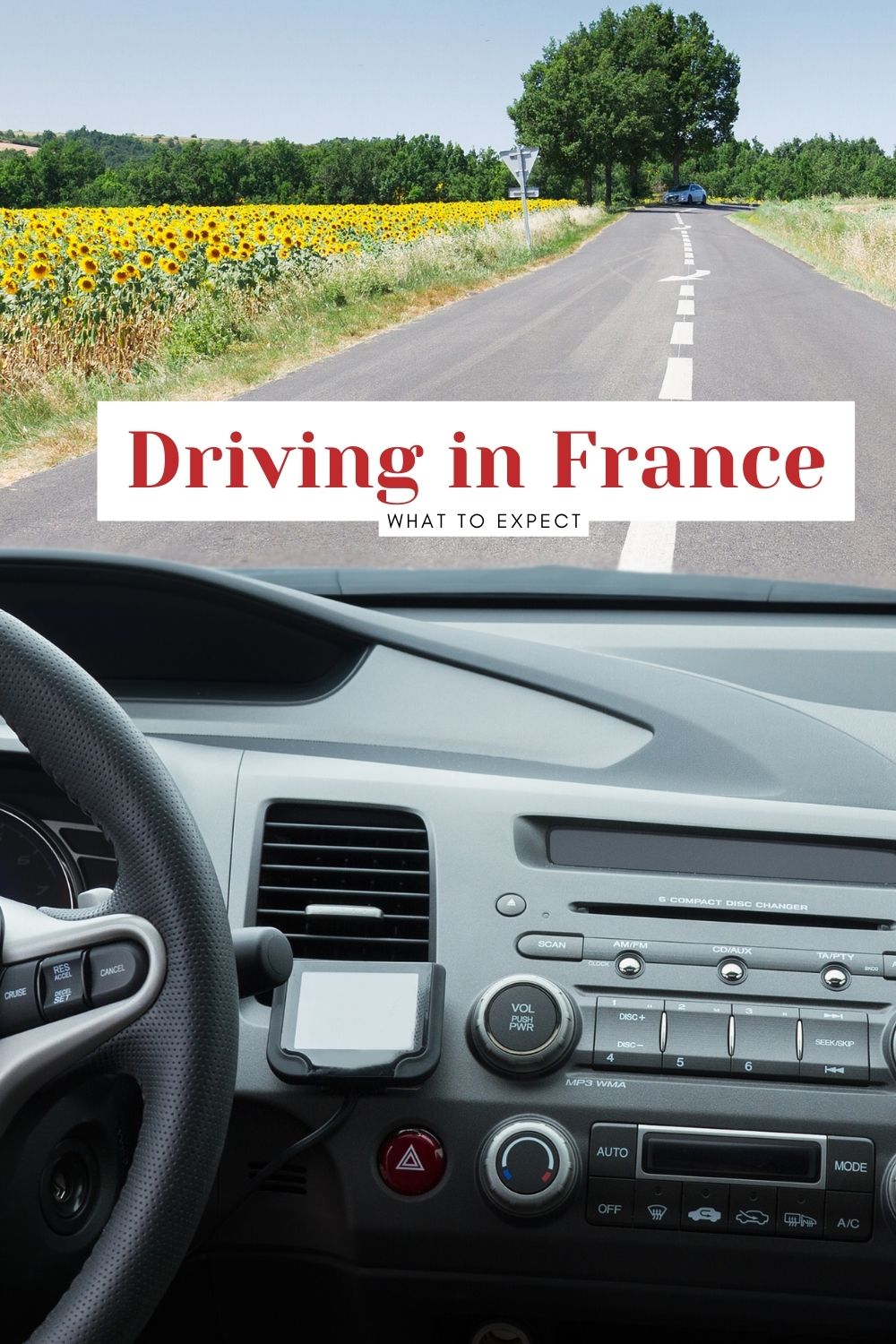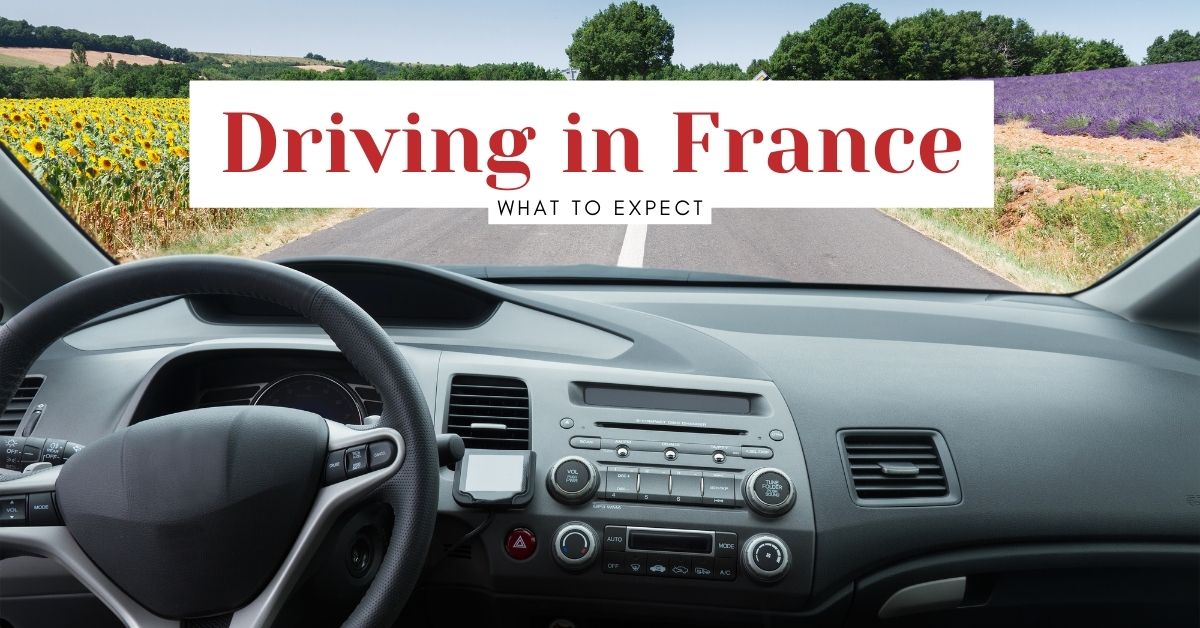
Driving in France
Bonjour fellow road trippers!
If you’re dreaming of an unforgettable adventure through the captivating landscapes of France, then pack your bags, fasten your seat belts, and get ready to embark on a road trip of a lifetime! Depending on who you are, driving can be daunting even in your own country but taking that extra step of renting an unfamiliar vehicle and trying to decipher the lay of the land in a very new land adds a challenge, to say the least. But if you’re courageous enough to step into the driver’s seat, you’ll be rewarded with the kind of freedom that probably got you driving in the first place. France is a huge country (from a Brit’s point of view) but more so it’s so diverse from one region to the next, so if you’re a foodie (being on this blog I’ll bet you are 😉 ) you won’t regret giving yourself the chance to move around a little more than if you were relying on trains and planes.
So, to ensure a smooth and enjoyable journey through these enchanting countries, I want to equip you with essential driving tips and resources for navigating the roads with confidence.
First Stop: Document Check
If you’re a US citizen planning to visit France for a holiday or stay of fewer than 185 days, you’ll be happy to know that your US driving license should be accepted as long as it’s valid. However, it’s essential to check the specific requirements, as some states might require you to obtain an International Driving Permit (IDP) before traveling. The IDP serves as an official translation of your US license and is often recommended for peace of mind.
For US citizens with an EU-issued driving license, there’s usually no need for an IDP, and your license will be valid for driving in France as long as it’s full and in-date. However, always double-check the specific regulations based on your EU-issued license.
Now, whether you’re driving a French-registered car or bringing your vehicle from the US or another EU country, there are a few crucial documents you must have with you. Make sure to bring your valid car insurance certificate and vehicle registration documents, as it’s a legal requirement for all drivers in France to carry them at all times. If your car is registered in France, don’t forget to display your valid car insurance and control technique certificate in your car window.
Additionally, it’s mandatory to carry a reflective jacket and a warning triangle in your car at all times. While it’s not a legal requirement, it’s also a good idea to carry spare bulbs.
Remember that all cars must have functional front and rear seatbelts, and it’s a fineable offense if they are not worn by both the driver and passengers. Furthermore, keep in mind that children under ten years old are not allowed to sit in the front seat of a car. Safety is paramount!
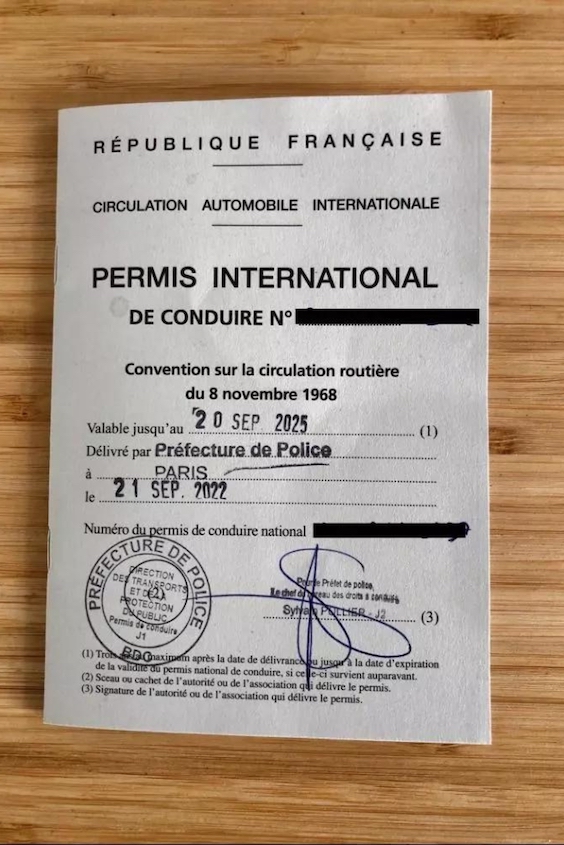
Right or Left?
Here’s the deal: in France, they drive on the right side of the road. A bit of a switcharoo for a Brit like me, but for most others, no worries, you’re probably already used to it!
Here’s a language tip: in French, gauche is left and droit is right. Now, you might hear about the priority to the right – la priorité à droite.
The “priorité à droite” rule in France is a traffic regulation that gives priority to vehicles coming from the right at intersections or junctions without traffic signs or signals. When approaching such an intersection, vehicles on the right have the right of way. This means you must yield and let them pass before proceeding. Even if you are on a main road, vehicles entering from minor side roads to your right have priority. However, if there’s a solid line with a STOP sign or any other traffic sign indicating priority, the rule does not apply. Stay vigilant, watch for road signs, and be ready to yield when necessary to ensure safe driving in France.
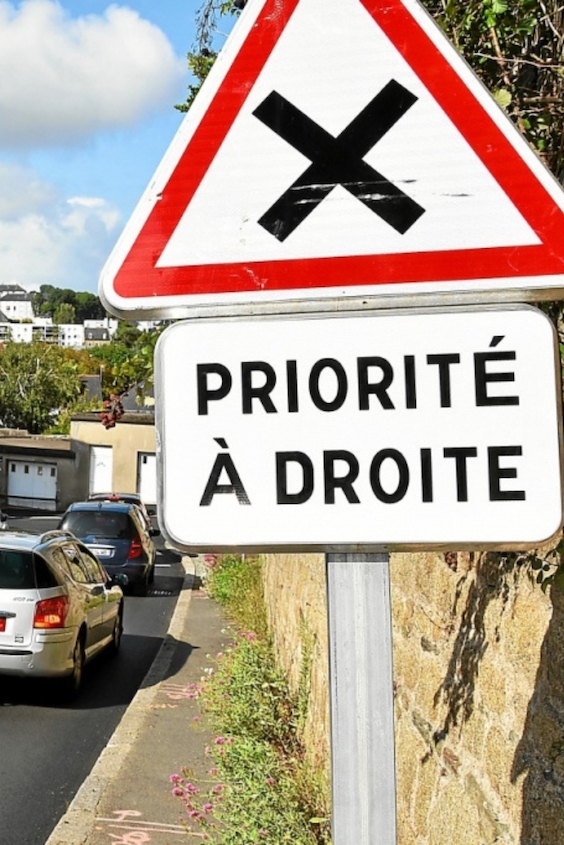
Easy on the Gas: Speeding
Different roads, different speed limits!
In France, speed traps are quite common, and the fines issued on the spot can be steep. It’s essential to be aware that radar detectors are illegal here, and getting caught with one can result in hefty penalties, including the confiscation of the equipment and even your vehicle. To avoid any trouble, make sure to disable the safety camera alerts on your Satellite Navigation System.
When you’re entering a town or village, pay close attention to the speed restrictions. They start as soon as you spot the sign displaying the name of the village and end when you see the sign with a cross through the name.
Now, let’s break down the speed limits unless indicated otherwise. On the autoroute or highway/motorway, you can zip along at 130 km/hr, but when the weather turns wet, the limit drops to 110 km/hr for safety reasons. Dual carriageways allow speeds of 110 km/hr, and again, it’s reduced to 100 km/hr during wet weather.
On main roads and country roads, the speed limit is set at 80 km/hr. And when you find yourself in built-up areas like towns or villages, make sure to slow down to 50 km/hr.
If you don’t manage to keep within the limits…
In most cases, speeding fines typically amount to €135. The exact penalty amount can depend on what you were caught doing though. You can find a guide to different driving penalties in France here. However, here’s a crucial tip: if you settle the typical fine within 15 days, it’s reduced to €90. So, it’s in your best interest to pay promptly if you receive a ticket.
On the flip side, if you don’t pay or contest the fine within 45 days, the amount shoots up to €375. Ouch!
You can pay a speeding fine online, simply visit www.amendes.gouv.fr, and you can easily pay using your credit or debit card. The website is available in English, making it user-friendly for everyone. Alternatively, you can choose to send a cheque using the attached payment form.
That all said, my best advice is to not speed in the first place!
If you find yourself in a situation where you want to contest a speeding ticket—for instance, if you weren’t the one driving the vehicle when the offense occurred—there’s a convenient online option available. You can do this through the website antai.gouv.fr, which is also accessible in English. The site will guide you through the entire process and provide all the necessary information you need. Be sure to have your driving license details on hand, as well as those of the person who was driving the vehicle at the time of the offense. After providing the relevant details, a separate Avis de Contravention will be sent to the person involved, either by post or email, depending on your choice.
Roundabouts: The Circular Adventure
Roundabouts are like motor dance floors, ain’t they? Don’t worry, we’ll groove through these circular wonders like champs. It’s all about the flow!
In France, roundabouts are very common, and they’re a bit different from what you might be used to if you’re from the US. Instead of having traffic lights or stop signs, roundabouts keep traffic flowing smoothly without the need to come to a full stop.
As you approach a roundabout, you’ll notice yield signs or triangular road signs. When entering the roundabout, always yield to the vehicles already inside it. Look to your left and give way to any cars approaching from your left side.
Once it’s clear and safe, enter the roundabout and stay in your lane. Go with the flow of traffic around the circle, keeping a steady pace. Remember, vehicles inside the roundabout have priority, so be cautious and patient.
If you need to exit the roundabout, use your right turn signal and carefully merge into the appropriate exit lane. You don’t need to stop when exiting; just yield to any pedestrians or cyclists on the crosswalk.
Road Signs: Our Trusty Sidekicks
It’s a bit tricky navigating a foreign country with a new language (if you don’t speak French) and while road signs are typically symbolic =, if you had any doubts, here are some to look out for. In most cases, you will see the universal image before any writing though so as long as you passed your driving test you’ll most likely get by without too many hitches.
First up, stop signs still say stop – luckily this is a word the French use also!
But here’s where it might get more tricky:
In France, directional road signs are color-coded for easy identification:
- Blue signs indicate the Autoroute or highway.
- Green signs indicate ‘important’ or major roads.
- Yellow signs indicate temporary roads, often with déviations or detours.
- White signs indicate local roads.
Road markers, known as “bornes,” are also available on the side of the road. The letter on the marker indicates the type of road, and the color further clarifies it:
- C & R (black letters on a white background) stands for Communal/rural roads.
- D (black letters on a yellow background) represents Departmental roads.
- N (white letters on a red background) indicates National roads.
- A (white letters on a blue background) denotes Autoroutes or highways.
- E (white letters on a green background) indicates European roads.
Low Emission Zones:
To combat air pollution in Paris and several other French cities, they have implemented a “Low Emission Zone” (faibles émissions mobilité is what you’ll see under the sign) initiative. This means that all vehicles must showcase a Crit’Air sticker, which indicates their carbon emissions level. If a vehicle doesn’t have this sticker, the owner may face a fine as a consequence. The aim is to encourage cleaner vehicles and promote better air quality for everyone.
To know that you’re about to enter one of these zones you’ll see a hollow red circle sign and underneath it is written “circulation restreinte” which is like saying reduced traffic. You’ve exited the zone when you see a similar sign but “fin de zone circulation restreinte” written and the color will be grey and black with a line diagonally through the circle. You can read more about these zones here.
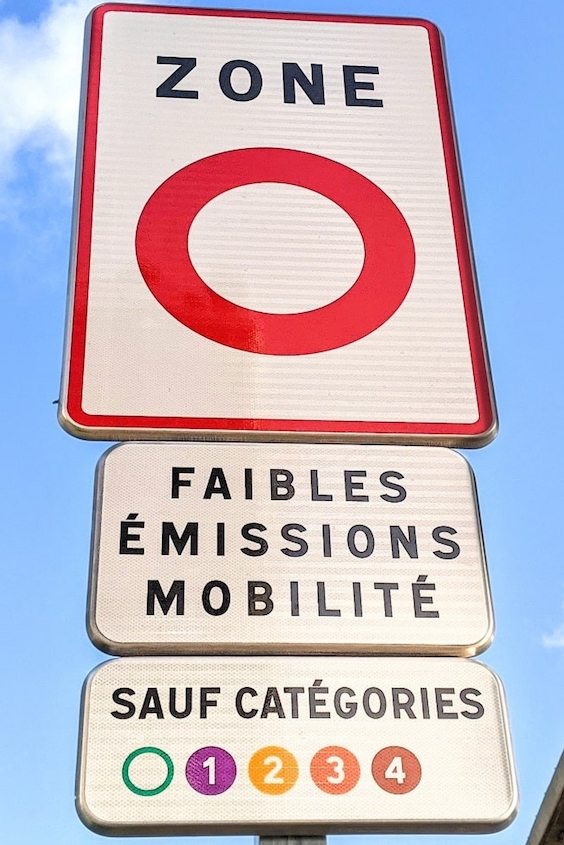
Parking Like a Pro
Stay away from no-parking zones, disabled spots, and loading areas, and we’re good to go. For this kind of thing it’s a pretty similar situation to back home. You might want to keep in mind where and when you can park. Be aware of parking signs and restrictions to avoid any surprises.
When you’re in major cities, you’ll likely encounter multi-story car parks, typically you’ll grab a ticket at the entrance and pay when you leave. Most car parks accept card payments, but always remember to take your ticket to open the barrier.
In city and residential areas, street parking is usually allowed unless marked otherwise. Look out for “Stationnement interdit” signs, which means “no parking.” Just like anywhere else, avoid blocking entrances, yellow lines, and parking too close to junctions. Being mindful of where you park will save you from getting a parking ticket.
Do I Pay to Park?
Keep an eye out for the word “PAYANT.” It means you need to pay for parking at these areas. Look for a parking meter and be ready with your car registration number, as you might need to enter it. Payment options usually include cash, card, or even mobile phone. Once paid, display your parking ticket clearly on your front windscreen.
In most places, parking is free between 12 pm and 2 pm, after 7 pm, and on Sundays. The parking meter will have the specific details, so just check before leaving your car.
In the Blue Zone
There is also a nifty parking option called “Zone Bleue.” In smaller towns, you’ll find these parking zones that offer free parking for an hour or more. The catch? You need a blue parking disc, known as “disque de stationnement.” Grab one from your local Tobacco seller (Tabac) or Maison de la Presse for a small fee. Just set the disc to your arrival time and display it clearly through your windscreen. Voilà! You can enjoy free parking.
If you or someone you’re traveling with needs disabled parking, no worries! Disabled car parking spaces are common throughout France and marked with a wheelchair sign. You must have a disabled parking card like the French Carte mobilité inclusion (CMI) or EU Disability Card to use these spaces legally.
Parking Fines
Now, let’s address the elephant in the room—parking fines! Nobody wants them, right? If you break the parking rules, you might end up with a fine issued directly onto your vehicle or sent to your registered address. The fine is typically €35, but if you pay within 15 days, it’s reduced. If your parking is super dangerous or obstructive, the fine may be €135, and you might even lose some points from your French driving license.
When you receive a parking ticket or “Avis de Contravention,” you’ll have 45 days to pay. Online payment options include bank card, cheque, or even by phone.
Your Toolkit for the Ride
We’ve got some secret weapons for our journey:
- International Driver’s License: You can get yours at https://www.idlservice.com/. Piece of cake!
- Driving in France: For more deets, check out https://www.interieur.gouv.fr/English/Road-Safety.
Ready to Roll? Let’s Do This!
With everything sorted, it’s time to rev up your wanderlust and hit the road! Soak in the beauty, savor mouthwatering delicacies, and create memories that’ll make us smile for years to come. Buckle up and let’s embark on this epic journey through France. Bon voyage, road trip champs!
We’ve had our fair share of traveler braving the roads in their own vehicle during our Culinary Holiday Week in Uzès and they have all found it to be very practical for making the most of their free time. Some even helped out by taxiing other visiters (but it wasn’t expected for them to do this at all and the beneficiary appreciated it a lot). Of course, after a day in Uzès the participants are already friends and cooking buddies so the company is often appreciated.
Any questions about driving in France, shoot us a comment below!
